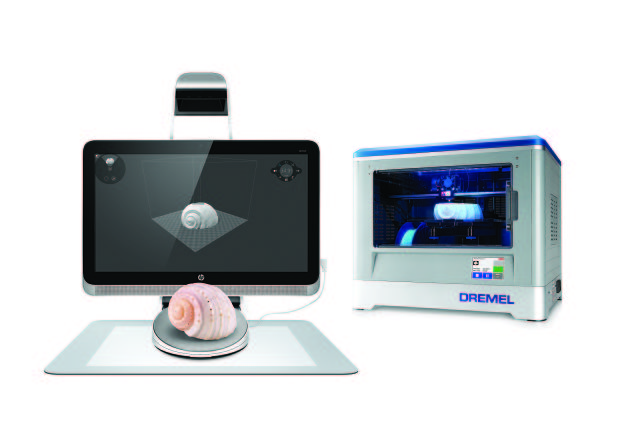A New Platform for Connecting the Physical and Digital Worlds

Kemi Jona is a research professor of learning sciences and computer science at Northwestern University. As the director of the Office of STEM Education Partnerships, he leads research and development projects in STEM curriculum design, cyberlearning and online and blended learning models. Over the past year, he led a study of several school systems that piloted Sprout, HP’s new all-in-one computer and 3D scanner. In this Q&A, he talks about the educational potential of a device that connects the physical and digital worlds.
 THE Journal: How does Sprout work?
THE Journal: How does Sprout work?
Kemi Jona: Sprout gives you a unique, hands-on way to interact with your content. Two touch surfaces work together to transform your desk’s surface into a digital-physical workspace. Sprout's all-touch user interface lets you control your content directly with your hands on either the 23-inch full HD touchscreen or the projected display on the 20-point capacitive Touch Mat.
The Illuminator (a capture and projection system that combines a scanner, depth sensor, hi-res camera and projector) is the heart of Sprout. It houses the Intel RealSense 3D camera and projection engine, which allow you to scan 2D or 3D objects and instantly display them on the Touch Mat.
THE Journal: What was the idea behind incorporating 3D scanning into the device?
Jona: Until now, the physical and digital worlds have largely been separated and digital creation has remained in 2D. The new scanning application allows capture of objects in full 3D.
THE Journal: How did you choose the schools involved in the pilot, and how long did they have to use Sprout?
Jona: The seven participating schools/districts included three public school districts and four private schools. The public districts represented both urban and suburban areas. As a condition of participation, we agreed not to share the identities of the participants in our pilot study.
Except for one private school, which had already acquired a Sprout on their own and requested to participate in the project, all other participants were selected by HP and provided with a complimentary Sprout PC. The schools had the Sprout PCs for about 6 weeks at the end of the school year.
THE Journal: How did students react to Sprout?
Jona: Sprout resonated immediately with students, who clearly saw it as different from a typical PC. One student, referring to movies like Minority Report that depict tangible user interfaces via special effects, said, “I feel like I’m in the future!”
One teacher related the very high level of enthusiasm among her students, saying, “The kids went crazy! In 24 hours we got a second one for the lower grades!" She added that she believes that, based on word of mouth from students, parents at the school may have purchased six Sprout systems for use at home.
One teacher talked about seeing Sprout sparking curiosity among her students. They would come into the room with Sprout and say, “What is this?” She observed kids coming in and “camping out” in front of Sprout, with some students coming in during recess to play with it. These are not typical behaviors associated with new PCs showing up in a school. When asked what aspects of Sprout seemed to be triggering these reactions, her impression was that having a large screen that is shared, the digital ink, and the digital/tangible experience of the touch mat were all contributors to the enthusiasm among her students.
A number of participating teachers observed that the Sprout’s touch mat invited collaboration by allowing multiple students to manipulate an image or 3D model at the same time. They would often notice a bunch of chairs pulled up to Sprout with students working together.
THE Journal: Were there any specific subjects or lessons in which Sprout was especially effective for students?
Jona: One participating school took advantage of the touch mat not simply to as an interface but to allow students to become tangible user interface developers. One middle school teacher worked with students to create Scratch programs that employed a tangible user interface, something they had not encountered previously. Students programmed a musical instrument with the interface being coded to play different notes based on where the instrument was touched on the touch mat.
At the high school level, one teacher saw an immediate application for Sprout in a bioengineering course. When his students were given the opportunity to explore Sprout and generate ideas for how they would like to use it, the idea of scanning body parts was very exciting to them, given how easy and immediate it is to do on Sprout.
The students worked on a telemedicine scenario whereby a person in a remote area without medical facilities might be able to scan a broken arm, hand or finger and then 3D print a custom cast or splint for it. Students were able to scan the top and bottom halves of their arms, then use AutoCAD to “stitch” the two halves together to create a full 3D model for their cast. Another idea suggested by the participating teacher was to have students use the 3D scanning feature to scan broken objects and then 3D-print pieces to repair these broken objects to promote sustainability and recycling of products.
In addition to seeing the pedagogical benefit of Sprout for introducing 3D design and printing before high school, teachers also noted a niche for Sprout as a tool for increasing the efficiency of the 3D design and printing process. Responding to the current lack of integration in the 3D scanning, design (CAD) and printing cycle, teachers felt that Sprout could provide a tightly integrated “all-in-one” 3D design and printing solution, reducing transaction costs of students having to move between multiple software and hardware tools.
THE Journal: What's the next step in Sprout's development?
Jona: The newly announced 3D Capture Stage is being eagerly anticipated by teachers and students, and should result in much richer applications for 3D scanning in classrooms. While the HP teams continue to work to make Sprout technology even more engaging, our primary focus is to help educators see how Sprout can transform learning.
Today, many computer labs in schools are still used solely for word processing or to create presentation slides. Replacing that lab with Sprouts turns that lab into an “imagination laboratory” or makerspace where children’s creativity and innovation can truly be unleashed.